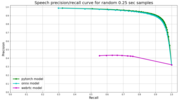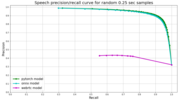[Open source, Машинное обучение, Звук] Modern Portable Voice Activity Detector Released
Автор
Сообщение
news_bot ®
Стаж: 7 лет 9 месяцев
Сообщений: 27286

Currently, there are hardly any high quality / modern / free / public voice activity detectors except for WebRTC Voice Activity Detector (link). WebRTC though starts to show its age and it suffers from many false positives.
Also in some cases it is crucial to be able to anonymize large-scale spoken corpora (i.e. remove personal data). Typically personal data is considered to be private / sensitive if it contains (i) a name (ii) some private ID. Name recognition is a highly subjective matter and it depends on locale and business case, but Voice Activity and Number Detection are quite general tasks.
Key features:
- Modern, portable;
- Low memory footprint;
- Superior metrics to WebRTC;
- Trained on huge spoken corpora and noise / sound libraries;
- Slower than WebRTC, but fast enough for IOT / edge / mobile applications;
- Unlike WebRTC (which mostly tells silence from voice), our VAD can tell voice from noise / music / silence;
- PyTorch (JIT) and ONNX checkpoints;
Typical use cases:
- Spoken corpora anonymization;
- Can be used together with WebRTC;
- Voice activity detection for IOT / edge / mobile use cases;
- Data cleaning and preparation, number and voice detection in general;
- PyTorch and ONNX can be used with a wide variety of deployment options and backends in mind;
Getting Started
For each algorithm you can see the examples in the provided colab or in the repo itself. For VAD we also provide streaming examples for a single stream and multiple streams.
import torch
torch.set_num_threads(1)
from pprint import pprint
model, utils = torch.hub.load(repo_or_dir='snakers4/silero-vad',
model='silero_vad',
force_reload=True)
(get_speech_ts,
_, read_audio,
_, _, _) = utils
files_dir = torch.hub.get_dir() + '/snakers4_silero-vad_master/files'
wav = read_audio(f'{files_dir}/en.wav')
# full audio
# get speech timestamps from full audio file
speech_timestamps = get_speech_ts(wav, model,
num_steps=4)
pprint(speech_timestamps)
Latency
All speed test were run on AMD Ryzen Threadripper 3960X using only 1 thread:
torch.set_num_threads(1) # pytorch
ort_session.intra_op_num_threads = 1 # onnx
ort_session.inter_op_num_threads = 1 # onnx
Streaming latency depends on 2 factors:
- num_steps — number of windows to split each audio chunk into. Our post-processing class keeps previous chunk in memory (250 ms), so new chunk (also 250 ms) is appended to it. The resulting big chunk (500 ms) is split into num_steps overlapping windows, each 250 ms long;
- number of audio streams;
So batch size for streaming is num_steps * number of audio streams. Time between receiving new audio chunks and getting results is shown in picture:
Batch size
Pytorch model time, ms
Onnx model time, ms
2
9
2
4
11
4
8
14
7
16
19
12
40
36
29
80
64
55
120
96
85
200
157
137
Throughput
RTS (seconds of audio processed per second, real time speed, or 1 / RTF) for full audio processing depends on num_steps (see previous paragraph) and batch size (bigger is better).
Batch size
num_steps
Pytorch model RTS
Onnx model RTS
40
4
68
86
40
8
34
43
80
4
78
91
80
8
39
45
120
4
78
88
120
8
39
44
200
4
80
91
200
8
40
46
VAD Quality Benchmarks
We use random 250 ms audio chunks for validation. Speech to non-speech ratio among chunks is about ~50/50 (i.e. balanced). Speech chunks are sampled from real audios in four different languages (English, Russian, Spanish, German), then random background noise is added to some of them (~40%).
Since our VAD (only VAD, other networks are more flexible) was trained on chunks of the same length, model's output is just one float from 0 to 1 — speech probability. We use speech probabilities as thresholds for precision-recall curve. This can be extended to 100 — 150 ms. Less than 100 — 150 ms cannot be distinguished as speech with confidence.
Webrtc splits audio into frames, each frame has corresponding number (0 or 1). We use 30ms frames for webrtc, so each 250 ms chunk is split into 8 frames, their mean value is used as a treshold for plot.

===========
Источник:
habr.com
===========
Похожие новости:
- [Информационная безопасность, Open source, JavaScript, Node.JS] CRUD для NMAP’а: решение для мониторинга открытых портов на хостах
- [Open source, Python, Data Mining, Машинное обучение, Звук] Мы опубликовали современный Voice Activity Detector и не только
- [Python, Программирование, Машинное обучение] Соревнование KAGGLE по определению риска дефолта заемщика. Разработка признаков
- [Облачные вычисления, Законодательство в IT, Социальные сети и сообщества, Звук] «Лайвстрим в рамках закона»: как соцсети ограничивают использование музыки, и к чему это приводит
- [Машинное обучение, Искусственный интеллект] Доббль: практичный подход с OpenCV и NumPy
- [Настройка Linux, Информационная безопасность, Open source] Linux exploits
- [Машинное обучение, Искусственный интеллект] Исследователи выяснили, что системы ИИ не различают предложения с перемешанными словами
- [Алгоритмы, Математика, Машинное обучение, Искусственный интеллект] Алгоритм обучения нейронных сетей с помощью нового вида чисел
- [Машинное обучение, Экология] Глубокое обучение в экологии: прогнозирование вспышек численности жука-короеда (перевод)
- [Настройка Linux, Open source, Разработка под Linux] Разработчики Linux рассматривают отказ от поддержки старых процессоров
Теги для поиска: #_open_source, #_mashinnoe_obuchenie (Машинное обучение), #_zvuk (Звук), #_stt, #_speech_recognition, #_vad, #_open_source, #_mashinnoe_obuchenie (
Машинное обучение
), #_zvuk (
Звук
)
Вы не можете начинать темы
Вы не можете отвечать на сообщения
Вы не можете редактировать свои сообщения
Вы не можете удалять свои сообщения
Вы не можете голосовать в опросах
Вы не можете прикреплять файлы к сообщениям
Вы не можете скачивать файлы
Текущее время: 29-Ноя 22:40
Часовой пояс: UTC + 5
| Автор | Сообщение |
|---|---|
|
news_bot ®
Стаж: 7 лет 9 месяцев |
|
 Currently, there are hardly any high quality / modern / free / public voice activity detectors except for WebRTC Voice Activity Detector (link). WebRTC though starts to show its age and it suffers from many false positives. Also in some cases it is crucial to be able to anonymize large-scale spoken corpora (i.e. remove personal data). Typically personal data is considered to be private / sensitive if it contains (i) a name (ii) some private ID. Name recognition is a highly subjective matter and it depends on locale and business case, but Voice Activity and Number Detection are quite general tasks. Key features:
Typical use cases:
Getting Started For each algorithm you can see the examples in the provided colab or in the repo itself. For VAD we also provide streaming examples for a single stream and multiple streams. import torch
torch.set_num_threads(1) from pprint import pprint model, utils = torch.hub.load(repo_or_dir='snakers4/silero-vad', model='silero_vad', force_reload=True) (get_speech_ts, _, read_audio, _, _, _) = utils files_dir = torch.hub.get_dir() + '/snakers4_silero-vad_master/files' wav = read_audio(f'{files_dir}/en.wav') # full audio # get speech timestamps from full audio file speech_timestamps = get_speech_ts(wav, model, num_steps=4) pprint(speech_timestamps) Latency All speed test were run on AMD Ryzen Threadripper 3960X using only 1 thread: torch.set_num_threads(1) # pytorch
ort_session.intra_op_num_threads = 1 # onnx ort_session.inter_op_num_threads = 1 # onnx Streaming latency depends on 2 factors:
So batch size for streaming is num_steps * number of audio streams. Time between receiving new audio chunks and getting results is shown in picture: Batch size Pytorch model time, ms Onnx model time, ms 2 9 2 4 11 4 8 14 7 16 19 12 40 36 29 80 64 55 120 96 85 200 157 137 Throughput RTS (seconds of audio processed per second, real time speed, or 1 / RTF) for full audio processing depends on num_steps (see previous paragraph) and batch size (bigger is better). Batch size num_steps Pytorch model RTS Onnx model RTS 40 4 68 86 40 8 34 43 80 4 78 91 80 8 39 45 120 4 78 88 120 8 39 44 200 4 80 91 200 8 40 46 VAD Quality Benchmarks We use random 250 ms audio chunks for validation. Speech to non-speech ratio among chunks is about ~50/50 (i.e. balanced). Speech chunks are sampled from real audios in four different languages (English, Russian, Spanish, German), then random background noise is added to some of them (~40%). Since our VAD (only VAD, other networks are more flexible) was trained on chunks of the same length, model's output is just one float from 0 to 1 — speech probability. We use speech probabilities as thresholds for precision-recall curve. This can be extended to 100 — 150 ms. Less than 100 — 150 ms cannot be distinguished as speech with confidence. Webrtc splits audio into frames, each frame has corresponding number (0 or 1). We use 30ms frames for webrtc, so each 250 ms chunk is split into 8 frames, their mean value is used as a treshold for plot.  =========== Источник: habr.com =========== Похожие новости:
Машинное обучение ), #_zvuk ( Звук ) |
|
Вы не можете начинать темы
Вы не можете отвечать на сообщения
Вы не можете редактировать свои сообщения
Вы не можете удалять свои сообщения
Вы не можете голосовать в опросах
Вы не можете прикреплять файлы к сообщениям
Вы не можете скачивать файлы
Вы не можете отвечать на сообщения
Вы не можете редактировать свои сообщения
Вы не можете удалять свои сообщения
Вы не можете голосовать в опросах
Вы не можете прикреплять файлы к сообщениям
Вы не можете скачивать файлы
Текущее время: 29-Ноя 22:40
Часовой пояс: UTC + 5
